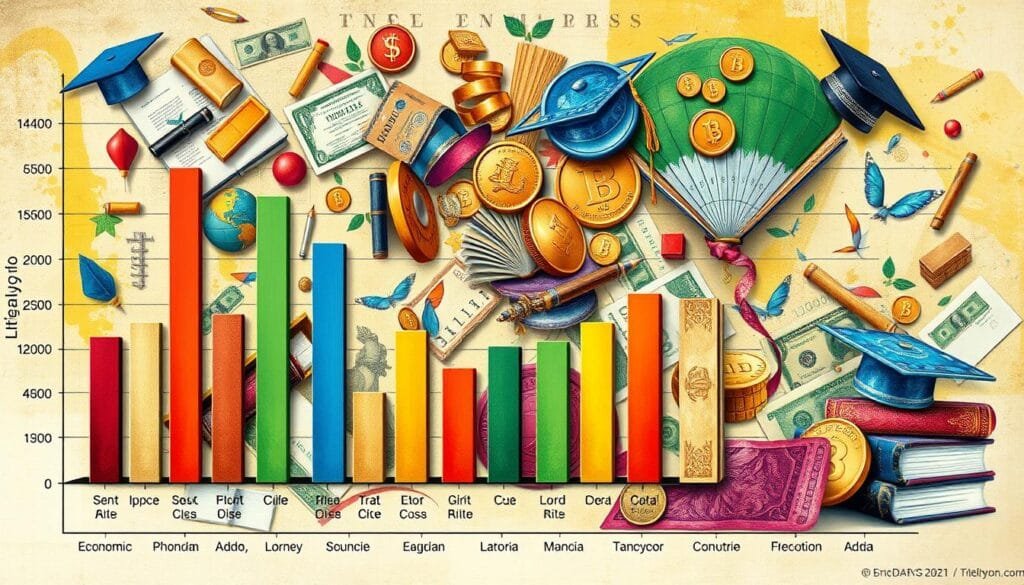When we talk about national wealth definition, we’re talking about all the wealth in a nation. This includes what both people and the government own. It’s about a country’s ability to make money and keep growing. The economic strength indicators tell us how well a country might do in the future. They show if we can survive and prosper despite economic challenges.
In today’s world, literacy rate impact matters more because financial markets are easier to enter. Understanding financial basics changes how we grow wealth as a country.
Financial literacy importance is huge. It gives people the skills to make smart money choices. These decisions shape not just their financial future but the nation’s economy too.
Knowing how to manage money affects everything. From picking a mortgage to understanding credit card rates. Being smart with money benefits the whole economy.
Financial knowledge isn’t just for personal gain. It also tackles wealth inequality and improves economic welfare. Let’s see how national wealth, economic strength, and literacy build a stable economy.
Key Takeaways
- National wealth encompasses the combined assets of a nation’s residents and its government.
- Economic strength indicators play a crucial role in predicting the longevity and prosperity of an economy.
- A high literacy rate, especially in financial matters, is critical for sound personal financial management.
- Financial literacy is essential in understanding and utilizing complex financial products responsibly.
- Improved financial decision-making leads to better investment choices and wealth outcomes.
- Technological advancements and workforce development are pivotal in driving economic growth.
The Core Indicators of National Wealth
Understanding Gross Domestic Product and Gross National Product is crucial. We also need to manage natural resources well and invest smartly overseas. These steps are key to determining a nation’s economic impact.
GDP and GNP Explained
GDP and GNP are key terms in economics related to national wealth. GDP looks at what a country makes within its borders. It shows how active and sustainable its economy is. GNP, on the other hand, counts all goods and services made by a country’s people, no matter where they are. This shows how its citizens impact the global economy. Both are essential for understanding a country’s economic policies and world standing.
Natural Resources and Their Role in National Wealth
Natural resources can really boost a nation’s finances. Things like minerals, oil, and forests bring in money from sales and exports. But, we must use these resources wisely. This way, they keep benefiting us without hurting future generations. This careful use is crucial for ongoing growth and protecting nature.
International Investments and Debts
Foreign investment can change a nation’s economy for the better. It brings in money, new technology, and jobs. When managed right, foreign investments help all sorts of sectors grow. This boosts the whole economy. But, national debt needs careful control. Too much borrowing can limit a nation’s economic freedom and future choices. Balancing investment and debt is key for good economic plans and policies.
“Economic strength flows from a well-managed state that harnesses its resources judiciously, encouraging growth while maintaining sustainability.”
A chart below shows important economic indicators for a nation’s health:
| Economic Indicator | Description | Significance |
|---|---|---|
| GDP | Total monetary value of goods & services | Measures overall economic activity |
| GNP | Goods & services produced by nation’s residents | Assesses citizens’ contribution to the economy globally |
| Natural Resource Exploitation | Utilization of natural assets | Contributes to wealth, requires sustainable management |
| Foreign Investment | Capital from external economies | Fuels domestic growth, innovation, and employment |
By watching and managing GDP, GNP, resources, and foreign investment well, we can guide our economic future. Doing so ensures a stable and prosperous path for our nation.
The Pillars of Economic Strength
We explore three key elements of a strong economy: fiscal health, trade balances, and technology’s role. Understanding these helps grasp what makes an economy strong and lasting.
Fiscal Health: Understanding Government Budgets and Debts
Fiscal policy health is key for an economy. When government spending exceeds income, it can lead to more public debt. To avoid too much borrowing, balanced fiscal policies are essential. This approach protects the economy and promotes long-lasting prosperity.
Trade Balances and Their Impact on Economic Strength
Trade balances show the difference between a country’s exports and imports. A surplus means a country sells more than it buys, which is good for the economy. On the other hand, a trade deficit can be risky if a country relies too much on foreign goods. It’s important to understand these to make the economy stronger and more resilient.
The Influence of Technology and Innovation on Economic Growth
Technological progress and innovation drive economic strength. An innovation-friendly environment gives a country a global advantage. It boosts productivity, develops new sectors, and updates old ones. Adapting to new technologies helps economies grow and stay relevant globally.

For a detailed look at economic health, we review comprehensive data. This data shows how each pillar affects the economy:
| Fiscal Aspect | Trade Balance | Technological Impact |
|---|---|---|
| Government budget deficit influences public debt levels | Trade surplus indicates strong domestic production | Innovation leads to market diversification |
| Balance between spending and revenue critical for sustainability | Persistent trade deficits may signal economic vulnerability | Technological advancements propel economic growth |
| Risk management through cautious fiscal policies | Analysis of import/export for economic strategy | Competitive edge sustained by embracing new technologies |
Navigating these economic pillars shows the need for balanced fiscal management, smart trade policies, and a focus on tech innovation. These are crucial for a strong, lasting economy.
What Is The National Wealth/Economics Strength and Literacy Rate
To define national wealth and economic strength measurement, we look at various indicators and data. National wealth sums up a nation’s financial and physical assets, minus any debts. It shows how well a nation stands economically. Economic strength includes wealth but also looks at growth and stability. We see this in measures like Gross National Income (GNI).
For example, the World Bank defines a Low Income Country (LIC) as having a GNI per capita of $1,035 or less. In contrast, a High Income Country (HIC) has a GNI per capita of $12,535 or more. This difference shows a big economic gap and highlights the need for good economic policies. The role of literacy rate significance in boosting economic growth is also key.

Literacy rate significance is crucial in economics. High literacy rates often mean better economies. In countries with almost everyone able to read, living standards and health are usually higher. Literacy is a key skill that boosts a country’s overall development.
Let’s look at different economies:
| Economic Indicator | LIC (Low Income Country) | HIC (High Income Country) | NEE (Newly Emerging Economy) |
|---|---|---|---|
| GNI Per Capita | $1,035 or less | $12,535 or more | Varies |
| Human Development Index (HDI) | Lower than 0.5 | Higher than 0.8 | Medium to high |
| Life Expectancy | Lower | Higher | Increasing rapidly |
| Literacy Rate | Lower | Very High (nearly universal) | Improving significantly |
| Infant Mortality Rate | High | Low | Declining |
In conclusion, a strong link exists between economic strength and literacy rates. High literacy can greatly improve a nation’s economy. This suggests investing in literacy pays off economically.
Decoding Financial Literacy: The Catalyst for Economic Empowerment
In today’s world, learning about money is more important than ever. We are dedicated to improving financial skills for everyone. This is key to building an independent economic society. Teaching financial empowerment helps people make better money decisions for a stable future.
The Critical Role of Financial Literacy in Personal Finance Management
Financial literacy teaches us how to make smart money choices. This is crucial for economic stability. It helps people understand financial products, manage debts, and plan for the future. By teaching financial skills, we prepare everyone to tackle financial challenges and be economically independent.
Implementing Financial Education in Schools: Effects and Strategies
Adding strong financial classes to the school curriculum is key. It teaches early money management skills. A policy requiring financial literacy classes changes student behaviors, prepping them for real-life financial choices. Yet, uneven policy implementation causes gaps in their financial understanding.
Financial Literacy and Gender Inequality: Bridging the Gap
Tackling pay differences with financial education is vital for equality. An inclusive curriculum that addresses economic gender issues empowers people. It encourages fairness in pay and job chances. Financial literacy is a powerful tool against economic inequalities.
By promoting detailed financial education, we fight wage differences. We’re on a path to a financially equal future for everyone.
Global Comparisons: Where Does the U.S. Stand?
In our study, the U.S. shines in many ways on the world stage. Yet, it can do better, especially in financial learning and economic performance. Compared to other nations, its financial knowledge is good but can improve, considering its economy.
The U.S. bounced back quickly after the pandemic. By early 2021, its economy was stronger than before, growing 6.1%. This growth tells us a lot about the financial health of the U.S. and its world rank.
| Economic Indicator | U.S. Ranking | Details |
|---|---|---|
| Real GDP Growth Rate | 122 | Low rank reflective of slow recovery pace in certain sectors |
| Unemployment Rate | 66 | Stands at 3.8%, showing strong labor market resilience |
| Literacy Education Expenditures | 40 | Indicates moderate investment in financial literacy programs |
| Core Inflation Rate | Inclusive Data | Core CPI inflation showing decline, current rate at 4.1% with owners’ equivalent rent |

Better financial literacy in the U.S. can boost its global rank. To achieve this, we need better education on money and economics. This will help fix gaps that affect people’s money skills and the nation’s economy.
The U.S. unemployment rate is also worth noting. It has been under 4% since January 2022. This shows the strength of the U.S. job market, which keeps consumer trust and spending high. Both are vital for the economy.
Managing inflation is another area where the U.S. does well. Keeping prices stable is key for living standards. Our analysis shows the U.S. is strong but highlights areas like financial literacy for improvement.
While the U.S. has a big impact globally, it can still grow in financial literacy and policy. Enhancing these areas is key for ongoing growth and better economic knowledge among citizens. This approach is crucial for more than recovery. It’s about long-term growth and learning.
Conclusion
The importance of knowing how to manage money goes beyond helping ourselves. It helps our entire country get richer. The success of financial education in making smart decisions common is clear. Financial education, as seen through the Jump$tart tool and advice from the President’s Council, is key for any nation’s economy.
Looking closer, we see the value of understanding money for everyone. It pays off for the whole country. States like Georgia, Idaho, and Texas show us this. Their laws on teaching money skills have actually improved credit scores and reduced late payments. Teaching these skills means more than just sharing how to handle money. It’s about giving people the tools to confidently face financial challenges, making our economy stronger.
At the heart of it, knowing how to manage personal finances and growing the country’s wealth are deeply connected. By teaching financial skills to everyone, especially to those who need it most, we build a future of success for all. So, it’s crucial we keep pushing for better financial education. This way, we aim for a future where everyone can thrive economically.
FAQ
What is the definition of national wealth?
National wealth means all the money and property owned by a nation, after paying what it owes. It shows how strong a country’s economy is.
How are economic strength indicators measured?
Economic strength comes from many factors. GDP, job rates, government policies, trade, technology, and how many can read and manage money matter.
What impact does the literacy rate have on a country’s economy?
When people understand money, they make smarter decisions. This makes the whole country’s economy stronger because everyone plays a part in its success.
What is the importance of financial literacy?
Knowing about money helps people manage it well. It lets them plan, save, and invest wisely. This strength goes back into making the nation stronger.
How are Gross Domestic Product (GDP) and Gross National Product (GNP) related to national wealth?
GDP counts all the goods and services made within a country. GNP includes what citizens make anywhere. Both show how rich and contributing a country is.
What role do natural resources play in contributing to national wealth?
Resources like oil and timber add to a country’s riches. Selling these materials brings in money, helping the economy grow.
Why are international investments and national debts significant indicators of a country’s financial health?
Foreign investments can boost the economy by creating jobs and bringing in expertise. But, too much debt can hurt a country’s future growth and stability.
What is fiscal health and why is it important?
Fiscal health means the government manages its money wisely. Good management keeps the economy strong and ready for any challenges.
How do trade balances impact a country’s economic strength?
Trade balances show if a country sells more than it buys. Selling more means the economy is doing well, but buying more too often is a risk.
Why is technology and innovation important for economic growth?
New technologies and ideas help economies grow. They make work easier and create new job opportunities, keeping a nation competitive.
How does the U.S. compare globally in financial literacy?
The U.S. needs to get better at teaching people about money. Improving education can help close the money and wealth gap.
Why is it important to include financial education in schools?
Financial lessons in school prepare students for a good economic future. They learn to handle money well, helping to lessen money gaps in society.
How does financial literacy relate to gender inequality?
Teaching everyone about money can help fight gender inequality. Fair financial education helps everyone, making wealth and wage differences smaller.
